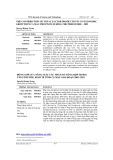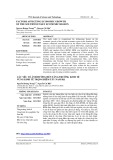
http://www.iaeme.com/IJM/index.asp 188 editor@iaeme.com
International Journal of Management (IJM)
Volume 8, Issue 2, March – April 2017, pp.188–198, Article ID: IJM_08_02_020
Available online at
http://www.iaeme.com/ijm/issues.asp?JType=IJM&VType=8&IType=2
Journal Impact Factor (2016): 8.1920 (Calculated by GISI) www.jifactor.com
ISSN Print: 0976-6502 and ISSN Online: 0976-6510
© IAEME Publication
A STUDY OF BRICS NATION BEING THE REAL
GROWTH DRIVERS OF WORLD ECONOMY
Rashmi Mishra
Research Scholar, Lalit Narayan Mithila University,
Darbhanga, Bihar, India
Dr. S.P. Thakur
Professor (Retd.), University Prof of Commerce & Ex Dean of the Faculty of Commerce,
Lalit Narayan Mithila University, Darbhanga, Bihar, India
ABSTRACT
The BRICS have in the past decade shaken the world economy with their
remarkable growth. Their share in the world GDP grew from 11 percent in 1990 to 25
percent in 2011. However, much of this success could be attributed to China and
India. While China indulged in investment based growth model, India was reaping the
benefits of its economic liberalization. Meanwhile Russia earned from the energy
needs that China’s growth had created and Brazil attacked its own macroeconomic
woes for a faster growth. South Africa, however, sneaked into the group and has been
the one most lagging behind. The question which this report attempts to address is
whether these nations are still the growth drivers of the world. There are several
factors which suggest that even though these economies might continue to grow they
cannot recreate the magic with their remarkable growth in 2000s. That period saw an
unprecedented growth partly because of the surge in the growth of these countries
owing to reasons inherent to their economies and partly due to the sluggish growth of
the richer economies. That was the period when they witnessed the major sub-prime
crisis of which the BRICS, to some extent, were shielded. The room to catch-up is now
low. The challenges which each of the BRICS is facing have been used to suggest that
their ruling period appears to have ended unless they revisit their strategies. Instead
the N11 have emerged as the next set of potential economies though they too cannot
be expected to replicate what BRICS achieved from 1999 to 2011.
Key words: BRICS, GDP, Role of BRICS, BRICS contribution to world economy,
Intra-BRICS trade
Cite this Article: Rashmi Mishra and Dr. S.P. Thakur, A Study of BRICS Nation
being the Real Growth Drivers of World Economy. International Journal of
Management, 8 (2), 2017, pp. 188–198.
http://www.iaeme.com/IJM/issues.asp?JType=IJM&VType=8&IType=2

A Study of BRICS Nation being the Real Growth Drivers of World Economy
http://www.iaeme.com/IJM/index.asp
189
editor@iaeme.com
1. INTRODUCTION
When a championed cricketer falls short of his best play, it takes a while to judge whether he
has slowed down temporarily or has he permanently lost the sheen. The same stands true for
the BRICS nations that had been performing no less than a champion cricketer who,
singlehandedly, drives his entire team towards victory. The same way BRICS once led a
global boom and helped revive the world economy forwards in the face of the financial crisis
but have now slowed drastically. The BRIC countries together made the world economic
output rise from 16 percent to 22 percent, from 2000 to 2008 to about 25 percent in 2011.
Combined they accounted for 30 percent of the increase in the global output during this
period. But what is now to be determined is whether these nations no longer have the caliber
to produce the same startling results or is it just a matter of time before they get back their old
charm. South Africa joined in 2011 and the acronym became BRICS. The role each member
was expected to play at the time of its formations was: Table 1 Member Role China Global
exporter of manufactured goods India Significant exporter of services Russia & Brazil
Exporter of raw materials China should be happy if it manages to reach its official target of
7.5 percent growth in 2013, way off from the double-digit rates that the country had come to
expect in 2000s. Growth in India too looming around 5 percent and Brazil and Russia
struggling at 2.5 percent, barely half of what they witnessed during the boom. Collectively,
they may just manage to meet previous year’s pace of 5 percent. This appears faster than the
sluggish rich countries, but it is the slowest emerging-economy growth in a decade. This
certainly marks the end of the dramatic and steep growth phase of the emerging economies
which witnessed economies climbing from 38 percent of the world output to 50 percent over
the past decade. However, over the next decade, these economies shall continue rising but
more gradually and subtly and the immediate effect of this slowdown should be manageable
though the long term effect would be more strongly felt.
1.1. Birth of BRICS
There cannot be a single factor that can be attributed to the coming together of these nations.
Several factors were at play in each of these nations which led to their remarkable growth in
2000s.
• China has consistently diverted its rural resources towards more productive activities in order
to satisfy its industrialization ambitions. From 1978, it gradually privatized agriculture and
opened it up to foreign investment and technology.
• The collapse of the USSR completely changed the dynamics at play. After an initial shock
from the disintegration, Russia witnessed a significant natural resource-driven growth rather
than chasing highly productive activities.
• Economic liberalization introduced in India post the 1991 reforms played their critical role in
uplifting the Indian economy. Governance shifted from tight control towards deregulation
which gave the industrial sector a lot of room to grow.
• The apartheid in South Africa had ended with the release of Nelson Mandela in 1990. This
opened the South African economy to the world economy.
• Brazil addressed its prolonged macroeconomic weakness from 1999-2003. The country today
has a small group of world’s leading firms and firms engaged in low skill work that employ 60
percent of the urban workforce.

http://www.iaeme.com/IJM
/
Figure 1
GDP (P
2. BRICS -
LOSING SH
We have all witnessed how i
bust, a period of recession. H
seem unlikely. Let us look at
India Russia Brazil 7 Experts
would soon no longer be able
balanced consumption
based m
for the country but fortunately
stimulate the economy if need
which few emerging countries
probability for them to adopt a
better equipped than before,
rates a
nd comparatively less d
that the era of record-
breaking
steam and its population is ag
built, there is lesser room for
PPP) was 8 percent of the U
though at a much slower rate.
remaining emerging giants. Fo
prices driven by Chinese gro
domestic credit; its current c
underlying economic speed is
much the same, where the do
potential for catch-
up with ine
without radical reforms and po
2.1.
Many Milestones Ahea
So does this suggest that if a
emerging-
market boom would
have created? This means that
world economies would grow
The past decade was rather un
Rashmi Mishra and Dr. S.P. Thakur
/index.asp
190
ed
(PPP, billion $), 1990
-2012
Source: World Bank, 2
HEEN?
in the past emerging
-
market booms were c
However, this time chances of these nations e
at the reasons why. 0 2000 4000 6000 8000 1
ts have for long pointed out that China’s invest
le to drive its growth which explains China’s sh
model. Its investment led growth ha
s resulted
ly it seems the Government has the potential t
ed be. This certainly makes a disaster less likel
ies pos
sess. And with the rich economies still
t a tighter monetary policy. Even if they did, th
e, with sufficient stashes of foreign reserves,
s debt and mostly in domestic currency. But
ing growth seems over. China’s investmentled
ageing fast and since it is prosperous owing t
r improvement. About ten years ago China’s
US while now it is 18 percent. But China w
e. China’s slowing down would certai
nly impac
For instance, Russia’s speed was fuelled by a
growth. Brazil raced up due to the surge in
t combination of infla
tion and slow growth
is lot lower than expectations. India’ growth
double
-
digit annual growth in GDP led investo
nevi
tability. Certainly India’s growth rate can b
policies and definitely so if the magic of 2000s
ead
all the emerging economies slow down it wo
ld no longer be able to fill the void which we
hat without a stronger recovery in the US, Jap
w at a much slower pace than todays’ lackluste
unusual. It was filled with China’s boom which
editor@iaeme.com
, 2013
closely followed by
s encountering a bust
10000 120
00 China
estment
-led economy
shift towards a more
ed in a lot of bad debt
l to absorb it and yet
kely. This is a quality
till frail, there is less
the BRIC nations are
s, flexible exchange
t the harsh reality is
ed model is losing its
g to th
e wealth it has
’s per capita GDP (at
a would keep pacing
act the growth of the
a surge in the energy
in commodities and
th indicates that the
h story is also pretty
stors to obfuscate its
be enhanced but not
0s is to be recreated.
would mean that the
weak rich economies
apan and
Europe, the
ter pace of 3 percent.
ch was disruptive not

A Study of BRICS Nation being the Real Growth Drivers of World Economy
http://www.iaeme.com/IJM/index.asp
191
editor@iaeme.com
just because of the country’s size but also because of the deluge in exports and resulting
buildup of foreign-exchange reserves. It can be safely deduced that in future a balanced
growth from a broader array of economies would cause lesser ripples around the world.
Economists believe that the BRICS, who were hitherto on a double digit growth spree will
need to revisit their strategies, considering the shale-gas recovery in the US which is expected
to be a 8 turnaround for the superpower. The leaders of the BRICS now to need to pull their
strings to propel the growth. So far, out of the BRICS, China has been the most committed
towards reforms and growth. India has demographic favorable factors but both India and
Brazil need to ignite their reformist zeal. Another remarkable change uprising is that in the
economic mood. Earlier Washington preached economic liberalization and democracy to the
emerging nations. But all this while China grew while Washington crunched and the
Eurozone was caught up in a perennial rough patch. Thus their ideologies have been
challenged.
3. GOLDEN ERA
Before studying the milestones the BRIC nations achieved in the past decades, an important
insight drawn from this research was that these nations started from a very low ebb. They had
large amounts of unused labor, resources, low-cost structures owing to lesser regulations back
then and favorable demographics. Nevertheless the credit cannot be taken away about how
remarkably these nations have advanced from such a low base point.
3.1. BRICS Accomplishments
Back in 1990, the BRICS together accounted for less than one-third of the world GDP on the
basis of the purchasing power. However, from 2003 to 2012 this share grew rapidly by more
than a basis point each year.
Figure 2 BRICS Market share of World GDP
This remarkable growth from 2003 to 2012 was unprecedented and experts say that
chances are low that it might be witnessed again. From 1960 to 1990s only about 30 percent
of the developing countries could enhance their per capita output faster than the US did. Till
the 1990s this catching-up was lackadaisical but thereafter it accelerated beyond anyone had
expected. Now 73 percent of developing countries managed to outperform America, which
could be partly attributed to America’s own sluggish growth following the sub-prime crisis.

Rashmi Mishra and Dr. S.P. Thakur
http://www.iaeme.com/IJM/index.asp
192
editor@iaeme.com
Of these 73 percent developing countries the most remarkable growth was displayed by the
BRIC nations. Although these four grew at different pace and for different reasons, their size
market them out as special. It was then forecasted that these economies would go on to
become front-rank economies and considering the past decade it can be rightly said so.
Talking about the accomplishments of BRICS without mentioning the crucial contribution
made by China would be worthless. China had been the major driver of the BRICS. It was
believed that without China BRICS would be BRI which was nothing but a soft bland cheese.
In the early 1990s and 2000s, the richer economies stated becoming debt ridden which
automatically initiated way for the inception of the golden era for the BRIC nations (as South
Africa was added only in 2011). Outsourcing to low- cost merging nations and rising export
demand were major factors in expediting the growth phase of these nations. The impressive
growth of the BRIC nations marked several changes in the world economy, some of them
have been wrenching. For instance labor and manufacturing cost dropped while commodity
prices increased. Owing to the large population size a more accessible and cheaper -4 -2 0 2 4
6 8 10 12 1990 1991 1992 1993 1994 1995 1996 1997 1998 1999 2000 2001 2002 2003 2004
2005 2006 2007 2008 2009 2010 2011 2012 BRICS US Source: IMF 10 pool of labor was
created that gradually led to wage stagnation which ensued rising income disparity in rich
economies.
Table 1 Economic & Social Indicators
2011 GDP (PPP)/
capita
GDP/capita growth
%, p.a. 2001-2010
PPP
Human Development
Index 2000-2011
BRAZIL 11,719 2.4 5
CHINA 8,466 9 10
INDIA 3,652 5.9 9
RUSSIA 21,248 4.6 8
SOUTH AFRICA 11,035 2.1 0
Source: Crisil Research, eDatabase Table 1 shows how BRICS varied among themselves
No doubt the dynamics of the world economy have changed as BRICS evolved and grew
but the era of rapid tumultuous growth seems to have ended. These economies would grow
but a more subtly rate. As a result, their progress would no longer shake the world as they
once did.
4. ARE BRICS NATIONS STILL THE GROWTH DRIVER?
As mentioned numerous times in the research report, BRICS no longer are growing at the
same pace as they once did in 2000s. Their year-on-year growth has been declining and fallen
to below a percentage point much in line with the sluggish growth rates of the BRICS. The
IMF forecasted that China would grow by 7.8% in 2013, India by 5.6% and Russia and Brazil
by 2.5%. Evidently this implies, the BRICS are contributing much less to the world economy.
Refer Fig-4

















![20 câu hỏi Quản lý dự án phần mềm có đáp án [mới nhất]](https://cdn.tailieu.vn/images/document/thumbnail/2025/20251003/hieu2004haha@gmail.com/135x160/78791759734259.jpg)


![Tài liệu Quản lý dự án: Kiến thức nền tảng toàn diện [chuẩn SEO]](https://cdn.tailieu.vn/images/document/thumbnail/2025/20250910/kimphuong1001/135x160/92631757496585.jpg)





